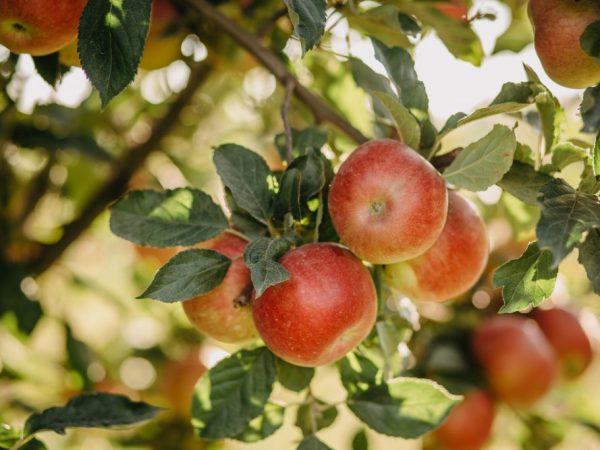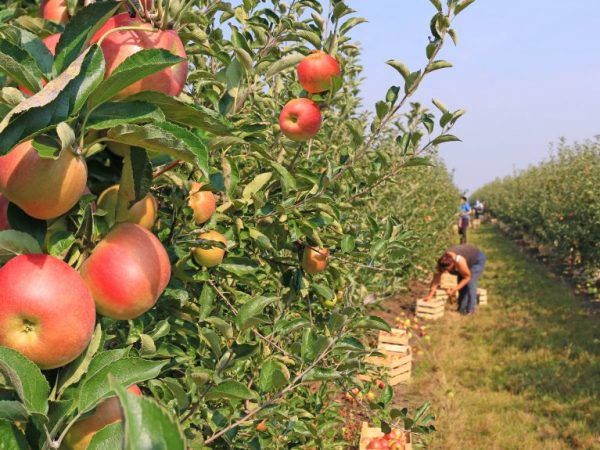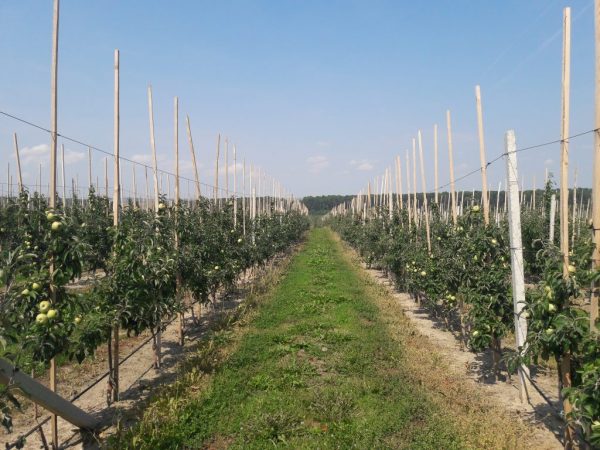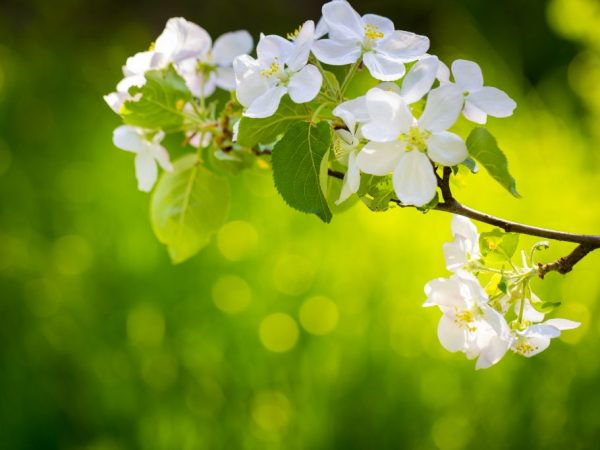Growing an apple tree Bashkir beauty
Every gardener dreams of a beautiful apple tree capable of producing a large harvest of large and tasty apples in any climatic conditions. In an attempt to deduce such a VP Strelyaev in 1927 achieved great success. The Bashkir beauty apple tree resulting from selection has become a favorite of many and quickly spread across territories with a harsh climate.
- Advantages and disadvantages of the variety
- Variety characteristic
- Description of the tree and fruit
- Taste
- Self-fertility
- Winter hardiness
- Disease and pest resistance
- In which regions are they grown
- Landing
- Timing
- A place
- Distance
- Care
- Watering
- Trimming and shaping
- Top dressing
- Protection against diseases and pests
- Features of ripening and fruiting
- Harvesting and storage
- Subspecies and variants
- Gardeners reviews

Growing an apple tree Bashkir beauty
Advantages and disadvantages of the variety
The main advantage of the variety is its extraordinary frost resistance. And also the following qualities stand out:
- high productivity;
- constant fruiting;
- versatility of use;
- good transportability;
- excellent keeping quality;
- easily adapts to any, even the most severe environmental conditions;
- quick recovery after freezing;
- grows on any soil.
Negative characteristics:
- the apple tree is practically defenseless against pests and some diseases;
- drought in the soil causes the discharge of set fruits;
- the variety is not fertile.
Variety characteristic
The apple variety Bashkirskaya Krasavitsa (or, in other words, Bashkirskiy Krasavets) was created for universal use.
It belongs to the early winter. It is used both on small household plots and on large farm lands.
Description of the tree and fruit
The growing young tree is not very tall, with a spreading crown of a rounded appearance, medium-leafy. In adult fruiting apple trees, it takes a wide pyramidal shape.
Skeletal branches grow almost at right angles to the trunk. The rest of the branches are straight, dark brown, woolly. A distinctive feature of the young is that the shoots have whitish, strongly pubescent tops.
The culture has large oval leaves. Small notches along the edge. The coating is matt, the reverse side is with a pile. There are a lot of veins on the surface. The color is emerald, intense.
The commercial characteristics of the fruits are high - of medium size, uniform shape, greenish-white color, with a bright pink blush and intense reddish stripes.
The maximum weight is 150 g, but mostly smaller specimens are found - about 100 g.
Taste

The fruits have good taste.
Apples with a weak aroma, but at the same time they are juicy, sweet, with a hint of sourness and a slight fruity bitterness. The texture of the pulp is grainy, crunchy.
Self-fertility
The Bashkir beauty belongs to self-fertile apple trees, which necessarily require the neighborhood of a pollinator.
For this purpose, varieties called Antonovka, Buzovyazovskoe, Titovka Seedlings are suitable.
Winter hardiness
It perfectly tolerates difficult environmental conditions, successfully withstands bitter frosts.
Sometimes non-critical freezing of a small number of shoots is possible, but the tree is able to quickly recover. Does not react negatively to the lack of a large amount of precipitation in the winter.
Disease and pest resistance
The tree is moderately resistant to diseases and pests. A lot depends on proper and timely care. Most often, trees get sick if they are weakened, so it is important to take preventive measures.
In which regions are they grown
The apple tree is common in Bashkiria, as well as in many other regions with a harsh, cold climate.
Landing
The Bashkir handsome man is unpretentious to the conditions and place of growth, but further yields completely depend on the observance of the technology of planting an apple tree and subsequent care.
The seedling is chosen without breaks, with a well-developed root system: it must have a healthy appearance.
It is required to saturate the tree with moisture, for this 6 to 8 hours before planting it is placed in a bucket of water.
Planting stages:
- a few weeks before planting, prepare a landing pit, the depth of which is at least 60 cm, width - 80 cm;
- fill it 1/3 with a mixture (2 tbsp of ash, 1.2 tbsp of potassium, 1.5 buckets of humus, 10 tbsp. superphosphate);
- drive in a peg from the north side, on which the seedling will be tied up - this will save it from gusts of wind;
- put a seedling in the hole, cover it with earth, tamp,
- leave 5 cm of the root collar above the ground;
- water abundantly, cover with dry earth on top;
- tie a tree to a support, cover the trunk circle with wood ash mulch mixed with humus or sawdust.
Timing

Planting is recommended in the fall.
This variety is best planted in early October. In regions with very cold climates, you can wait until spring for the seedlings to take root and take root well.
A place
For disembarkation, we choose a warm, well-lit area located on a hill, in which there are no drafts and strong gusts of wind, especially from the north. The soil is suitable with a neutral level of acidity, light, loamy or black soil.
It is important to check that in the selected area the groundwater is at a depth of at least 4-6 meters from the surface, otherwise water will stagnate and provoke root rot.
Distance
For the comfortable development of trees in the garden and easy maintenance, planting is carried out according to the 4x4 m scheme.
If this condition is met, the trees will have enough sunlight and the yield will always be maximum.
Care
The correct development of the apple tree, its immunity, the shape of the crown and further yield are entirely due to the observance of the rules of care.
Watering
For young trees planted in spring, the most important part of maintenance is regular watering with sufficient water.
It is important that the soil does not dry out completely. As it grows, the amount of watering decreases and the amount of fluid used increases.
Mature trees are watered every 4 weeks, in the absence of rain, watering is done twice a month.
After irrigation, the peri-stem circle should be covered with humus or compost with a layer of 8-10 cm. This will help retain moisture and protect against crust formation on the soil surface.
The last autumn water-charging irrigation is required after harvesting - the roots are saturated with water, and this creates additional natural protection from frost.
Trimming and shaping
Pruning is recommended twice a year to rejuvenate the tree, increase yields, thin out branches and reduce the risk of disease.
Damaged shoots, branches growing inside the crown, tops and short twigs that duplicate skeletal branches on the tree trunk should be removed regularly.
Crown formation begins in the 2nd year of the tree's life. 2-3 branches are left on the central trunk, growing in different directions. It is important to ensure that the bole remains 1/3 higher than the rest of the branches.
Top dressing

Fertilizers help the tree develop properly
A year after planting, the first feeding is carried out according to the following scheme:
- urea solution (50 g per 10 l of water) is applied under the root of the apple tree in the spring;
- fertilizer "Ideal" or sodium humate is applied in summer;
- the introduction of potassium-phosphate fertilizers (mix 350 g each and scatter under a tree) is carried out in the fall.
In spring and summer, it is necessary to apply nitrogen-containing fertilizers (apply 500 g of urea under each tree and loosen the topsoil). All fertilizing is carried out after watering.
In the fifth year of life, when fruiting begins, you will need to feed it four times a year. In the summer, foliar dressing is done with a urea solution (use according to the instructions).
Before wintering, in order to strengthen the immunity of the tree, a preventive treatment of trees with a solution of ferrous sulfate is carried out (use according to the instructions).
Protection against diseases and pests
One of the most dangerous diseases of the apple tree is the black leg. To combat this and concomitant diseases, insecticides are used: Antrakol, Skor, Topsin (use according to the instructions).
Of the pests, the most dangerous is the apple moth. To get rid of this pest and other insects, use: Karbofos, Fastak, On the spot, Kemifos (use according to the instructions). The protection effect lasts about 2-3 weeks.
To destroy aphids, use a soap solution, to prepare 300 g of grated soap, dissolve in 2 liters of warm water, add another 8 liters of cold water.
In late autumn, rodents do great harm to trees. To protect the trunk, it is wrapped with a special material, roofing felt, or covered with spruce paws. They remove the leaves that have fallen from the tree in the fall, spud the trunk circle, cover with mulch.
The winter sun damages the bark of trees as well as rodents. To avoid this, at the end of January, the trees are whitewashed with lime or chalk mortar. This helps protect the bark.
Features of ripening and fruiting
According to the description, the Bashkir handsome apple tree begins bearing fruit at the age of 4-6 years. The first apples ripen at the end of summer, and if it was cold, in September.
From one adult tree, 80-90 kg of fruits of the same size can be harvested.
It is very important to harvest on time, because he may fall.
Harvesting and storage
A week after the start of ripening, they start picking apples. Carefully plucked fruits are perfectly stored for 3 - 4 months in a normal room and about six months in a cool dark place. Perfectly transported.
Subspecies and variants
Thanks to the labor of breeders, there are two subspecies.
- Autumn. When the variety was crossed with Welsey, the ripening period of the crop in the resulting seedling shifted to a later date. The plant is of medium height, bears fruit annually.
- Early. Grafted onto a clonal dwarf stock, the apple tree changes not only its size and some characteristics, but also the time of fruiting. The tree gains a number of advantages: the compact crown format makes it easy to care for and harvest. Apples ripen in August.
Gardeners reviews
Subject to the planting technology and little care, the Bashkir Beauty variety is capable of producing an excellent harvest of delicious, sweet apples of universal use in various climatic conditions.
The description of the culture indicates that this variety is not capricious, undemanding to care for and any gardener can grow it, without much knowledge of agricultural technology.

